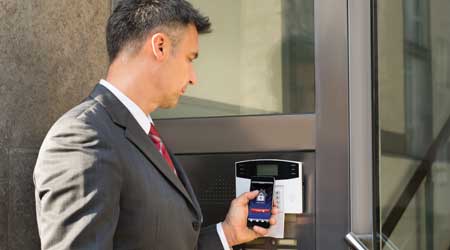3 Steps to Improved Security
By focusing on assessment, specification and implementation, managers can streamline installation and enhance the access control of facilities
Increasing risks to buildings, their contents and the people who work in them or visit are prompting maintenance and engineering managers to re-examine their facilities’ security systems in general and their access control systems in particular. Access control is simple in concept: Provide a means of letting in only those people who should have access while keeping all others out.
While simple in concept, implementation can present a host of challenges. Any measure implemented to limit access will impact the operation of the facility. A measure that is too strict will interfere with operations. A measure that is too lax will hamper security. For an access control system to succeed, managers must find the right balance between the two.
Making the issue even more challenging is the realization that no one size fits all when it comes to building security and access. Managers need to match systems to the specifics of the application, and systems must be flexible enough to change as conditions and operations in the building change.
By using a three-step process, managers can navigate the process of upgrading their existing access control system to meet the needs of their facility now and into the future.
Step 1: Assessment
Perhaps the most important step in a successful upgrade to a facility access control system is developing an understanding of products and measures in place, as well as occupants and assets requiring protection. Different buildings have different security requirements. Not all areas within a particular building have the same security requirements.
Managers should spell out in writing the goals for the security system — what needs protection and why. The more detailed and specific this document is, the greater the chances are for success.
Where do most employees enter and exit the building? How do visitors enter, and where are they most likely to go once in the facility? Do deliveries come through a dedicated entrance? Are delivery personnel free to go anywhere within the facility, or are they restricted to a specific area, such as a reception counter? How should the system respond in the event of an emergency?
Whatever system is installed, it must take these factors into consideration to provide security without stopping occupants from carrying out their daily activities. Take a close look at the existing system in order to identify weaknesses, and identify where improvements are possible. Look beyond the doors. Fencing, lighting and landscaping all are factors that impact security.
Next, look at the doors and the way visitors and occupants use them. Are the doors made of wood, glass, or metal? Do they close automatically or manually? If automatic closers are in place, how long does it take for the door to fully close?
Consider the other door hardware in use. Do the hinges have non-removable pins? How is the door frame attached to the structure? Can it withstand an attempt to pry the door open or pry the frame from the building? Are guard plates in places to prevent tampering with the lock?
Technicians should examine all doors and rate them based on two factors — how likely it is that a particular door will be breached and how severe the consequences of that breach would be. Addressing those two issues will determine the level of protection required.
The survey of the facility needs to identify gaps in the existing security system. Reviewing what you have and where the gaps are, and comparing them to your security goals will identify what changes must be made and functions must be included in the updated system.
Related Topics:















